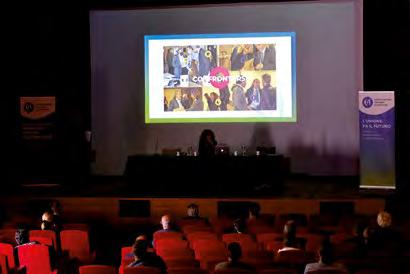
6 minute read
ACIS celebrates 10 years of activity and is preparing to meet new challenges
Come esce il settore del packaging in cartone da quest’ultimo biennio?
A seguito della chiusura dell’indagine Antitrust sul mercato del cartone ondulato abbiamo finalmente sperimentato una ‘normalizzazione’ dello scenario, purtroppo interrotta nell’ultimo periodo dalla crisi internazionale delle materie prime. Questo ‘ciclone’ che ha stravolto tutte le dinamiche precedenti e ci mette ogni giorno di fronte a nuove sfide organizzative, produttive, commerciali è arrivato proprio in un momento in cui la vivacità della domanda e la sempre maggiore richiesta di cartone in sostituzione ad altri materiali aveva tracciato una rotta molto positiva per le nostre aziende e il nostro settore in generale”. Parliamo del grande problema relativo alla carenza delle materie prime, che succede e come uscirne?
Advertisement
“La carenza delle materie prime ha purtroppo condizionato anche il nostro mercato in maniera molto pesante, con linee di produzione talvolta ferme e fornitori in sempre maggiore difficoltà per mancanza di carta. Purtroppo, questo scenario si traduce in un ritardo nei tempi di fornitura ai nostri clienti e provoca in generale un clima di grande incertezza. Credo che ne usciremo nel momento in cui i produttori di carta riusciranno a fronteggiare e superare le difficoltà dovute ai cari energetici o a politiche talvolta poco lungimiranti”.
Come vi ponete nei confronti degli altri stakeholder presenti nella filiera? Al di là dei problemi del passato, fare fronte comune verso le Istituzioni non rafforzerebbe le istanze da portare avanti?
“Abbiamo sempre mantenuto ottimi rapporti con i nostri partner e fornitori, le nostre Assemblee sono sempre momento di grande convivialità e scambio di competenze professionali. Per quanto riguarda i rapporti con l’Associazione di categoria che rappresenta i nostri fornitori di cartone ondulato, ora che si è formata una
ENGLISH Version ACIS celebrates 10 years of activity and is preparing to meet new challenges
WE INTERVIEWED ANDREA MECAROZZI, CEO OF SC.A.T, AND THE NEW PRESIDENT OF THE ASSOCIATION OF ITALIAN BOX MANUFACTURERS, THE THIRD TO LEAD THE ASSOCIATION THAT BRINGS TOGETHER ABOUT A HUNDRED BOX FACTORIES FROM ALL OVER ITALY. WITH HIM WE HAVE DRAWN UP A BALANCE SHEET OF THE LAST TWO YEARS WITH A LOOK AT THE FUTURE OF THE CORRUGATED CARDBOARD PACKAGING SECTOR, HIGHLIGHTING THE SALIENT POINTS OF HIS WORK PROGRAM
The election took place during the national assembly which was held last September 17 in Asiago, the first assembly in attendance after the pandemic which also saw the return of association’s industry partners, who animated a lively exhibition area set up inside Asiago Tourism Palace, where the assembly was held. A return, therefore, to normality for this assembly which also marked the tenth anniversary of ACIS, created in 2011 as a consortium and subsequently converted into an association. Ten years characterized by 24 assemblies, 110 boards of directors, 60 sponsors and hundreds of initiatives and projects developed to let the box factory sector grow and evolve and represent a very important category for the Italian production system and which looks towards the future with eyes of sustainability.
FACE TO FACE WITH ANDREA MECAROZZI, PRESIDENT OF THE ITALIAN BOX MANUFACTURERS ASSOCIATION Dr. Mecarozzi, what will be the characterizing points of your mandate? “There will be two main points. First of all, the institutional positioning of the association and consequently of the companies that are part of it. We believe it is essential to increase the weight of the box factories sector in our supply chain and give more voice to the needs of our members, also in relation to the particular historical moment we are facing, characterized by uncertainties and opportunities that perhaps had never been seen in these dimensions. We will then continue to work to increase the entrepreneurial culture and technical training of our people in the new scenarios through training courses developed specifically for the needs of our companies”.
How has the cardboard packaging sector come out over the last two years? Following the closure of the Antitrust investigation on the corrugated cardboard market, we have finally experienced a ‘normalization’ of the scenario, unfortunately interrupted in the last period by the international raw materials crisis. This ‘cyclone’ that has upset all the previous dynamics and puts us every day in front of new organizational, production and commercial challenges, has arrived precisely at a time when the liveliness of demand and the ever-increasing demand for cardboard as a substitute for other materials had charted a very positive path for our companies and our sector in general”.


nuova governance dopo un lungo periodo di transizione contiamo di potere riprendere nel breve termine un dialogo costruttivo, per portare avanti i numerosi interessi comuni a beneficio delle nostre aziende e del comparto degli scatolifici in generale”.
Quali sfide attendono il comparto del packaging in cartone ondulato per il futuro?
“Il cartone ondulato per le sue caratteristiche di riciclabilità e il suo bassissimo impatto ambientale sarà una scelta sempre più obbligata per il mondo del packaging. Lo sviluppo tecnologico e l’innovazione consentono sempre maggiori applicazioni e rendono il nostro cartone sempre più duttile e ideale in svariati campi fino a oggi non contemplati. Basti pensare all’industria dell’arredamento, ad esempio. La ormai inarrestabile sostituzione del cartone ad altri materiali da imballo inoltre aprirà ulteriori opportunità per le nostre aziende in settori chiave per il packaging, come l’alimentare. Insomma, gli scatolifici in grado di seguire o anticipare questi nuovi trend, di innovare e innovarsi potranno davvero cogliere le opportunità di un momento storico abbastanza unico”.


Let’s talk about the big problem related to the lack of raw materials, what happens and how to get out of it? “The shortage of raw materials has unfortunately also affected our market in a very heavy way, with production lines sometimes stopped and suppliers in increasing difficulty due to lack of paper. Unfortunately, this scenario results in a delay in delivery times to our customers and generally causes a climate of great uncertainty. I believe that we will come out of it when the paper producers are able to face and overcome the difficulties caused by expensive energy or sometimes short-sighted policies”.
How do you position yourself towards the other stakeholders present in the supply chain? Beyond the problems of the past, forming a common front towards the institutions could strengthen the demands to be pursued? “We have always maintained excellent relationships with our partners and suppliers, our assemblies are always a moment of great conviviality and exchange of professional skills. As regards relations with the trade association that represents our corrugated cardboard suppliers, now that a new governance has been formed after a long period of transition, we hope to be able to resume a constructive dialogue in the short term, to carry on the numerous common interests for the benefit of our companies and the sector of box factories in general”.
What challenges await the corrugated cardboard packaging sector for the future? “Corrugated cardboard due to its recyclability characteristics and its very low environmental impact will be an increasingly obligatory choice for the world of packaging. Technological development and innovation allow more and more applications and make our cardboard increasingly flexible and ideal in various fields not covered up to now. Just think of the furniture industry, for example. The now unstoppable substitution of cardboard for other packaging materials will also open up further opportunities for our companies in key sectors for packaging, such as food. In short, box factories able to follow or anticipate these new trends, to innovate and innovate will really be able to seize the opportunities of a quite unique historical moment”.










